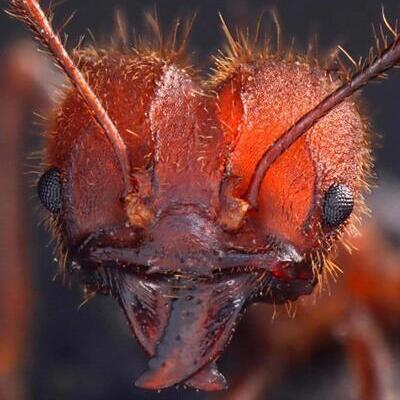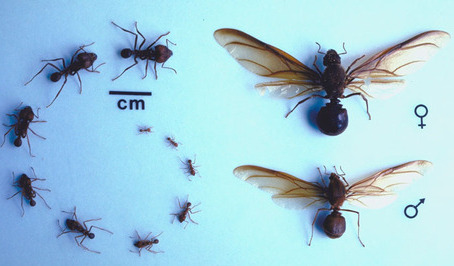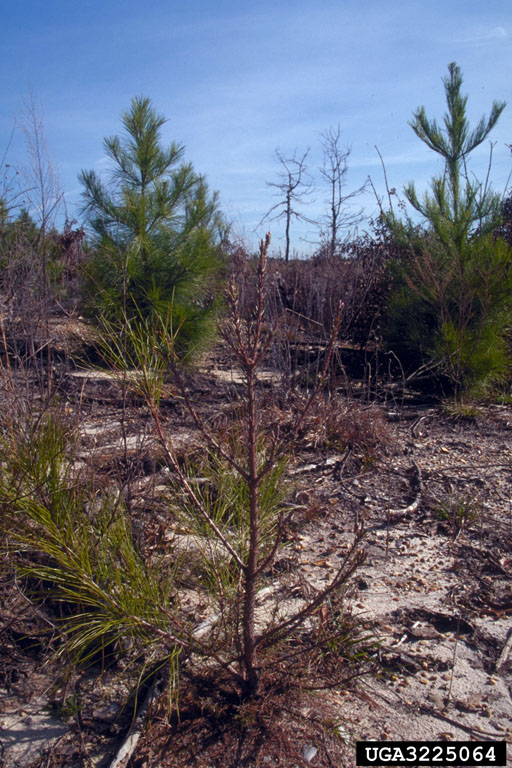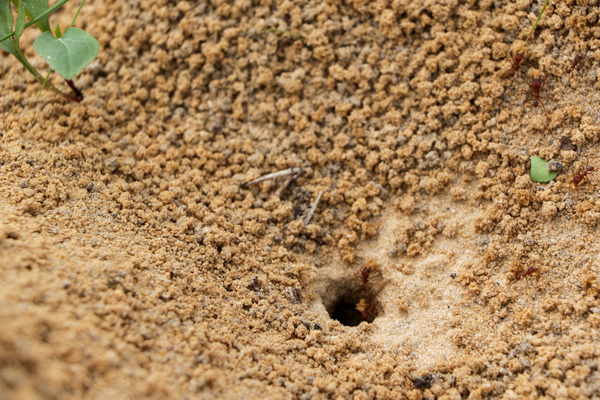The Texas leaf-cutting ant, Atta texana, is one of the most damaging pests in newly established pine plantations. It affects recently planted pine in 129 Texas counties, 13 Louisiana parishes, and can be devastating to citrus groves in South Texas.
Also known as town ant, parasol ant, or cut ant, the Texas leaf-cutting ant is the most northern representative of the genus Atta, considered among the most destructive insects to plants in the tropical and subtropical Americas.
They are generally confined to well-drained, deep sandy soils.
When establishing pine seedlings in areas where leaf-cutting ants are abundant, colonies should be treated chemically.
In an average year in East Texas, leaf-cutting ants kill pine seedlings on nearly 12,000 acres, with control and seedling replacement costs averaging $2.3 million. They can also be a considerable pest in residential areas where they forage on ornamental shrubs, rose bushes, fruit trees, and gardens. Harvested plant material is used to cultivate a fungus which serves as the ants’ principal food source.

Colonies
Leaf-cutting ant colonies have a social system consisting of three social groups (castes).
- Winged reproductive ants, also known as alates, are female queens and male drones. This caste is responsible for reproduction and dispersal of new colonies. Although the queen is technically an alate, she is in a caste of her own.
- The queen is the reproductive center of the colony and lives in chambers below the ground. Many colonies have five or more fertilized queens. Most eggs laid by the queens develop into sterile female workers.
- Wingless workers are the ants we are used to seeing. They are female, comprise most of the population of the colony, and serve no reproductive function.
There are often two million workers in a colony. Workers vary considerably in appearance and size. They range from 1/16 to 1/2 inch in length. Generally, large workers, or soldiers, serve to protect the nest. Medium-sized workers forage for plant material and construct tunnels and chambers. Small workers maintain fungal gardens and care for new born ants.
When colonies wake during the spring, some immature ants will develop into winged males and others into winged females. Workers will emerge to widen entrance holes and remove all vegetation hanging over them.
Then, mating flights occur in May or June on clear, moonless nights following a rain of at least ¼ inch. Mated females then disperse, land, and congregate with one another before establishing new colonies. Each female carries with her a plug of fungus to begin a new fungal garden.

Nest areas
The nest area of the leaf-cutting ant is marked by a series of crescent-shaped mounds surrounding entrance holes. Nest size varies from that of a single mound, or starter colony, to more than 1,000 mounds occupying up to one acre. More than five mounds per square yard.
The above-ground portion of the nest includes the central nest area and peripheral foraging mounds.
Underground, tunnels extend from the entrance holes to other tunnels or chambers built as deep as 25 feet. Three types of chambers have been observed:
- Garden chambers where plant material is incorporated into fungal mats to encourage new fungal growth and where brood, or newborn, ants develop.
- Detritus chambers where waste materials are stored.
- Dormant chambers of unknown function.
Worker ants, emerging from foraging mound holes, will often construct well-defined foraging trails that extend out an additional 300 feet or more in the search of suitable food sources.
Above ground activity depends largely on temperature. Foraging ants are highly sensitive to temperatures encountered along feeding trails.
In summer the ants remain underground during the heat of the day, often plugging the central nest holes with soil and vegetative debris. Apparently to regulate temperature and/or humidity within the nest. At dusk, when temperatures drop below 86 degrees, ants emerge to forage throughout the night.
Ants forage during winter but remain underground for long periods when temperatures remain below 50 degrees. Early spring and late fall are transitional periods when ants may be active during the day and night.
Pine damage

The worker ants forage on a wide range of plant species. Damage to pine seedlings occurs primarily during winter when grasses and weeds have died back and hardwood leaves have fallen.
The ants forage on all species of southern pine but given a choice the ants appear to prefer loblolly and shortleaf pines over longleaf and slash pines. This could be in response to differences in resin production.
When foraging on pine seedlings, the ants will completely strip the seedlings of foliage and buds and often clip off the stem at ground level and carry small plant fragments back to their nest. All seedlings within five acres or more around a central nest area can be killed within a month after planting.
When planting pine seedlings on deep, sandy soils within this insect’s geographical range, you should try to locate and treat any leaf-cutting ant colonies in or near areas to be planted before planting.
Colonies should be treated during late fall to early spring (November – April). This allows treatment of existing colonies and newly established colonies to get large enough to locate and treat. Untreated colonies will remain a source of reinfestation and future losses. Colonies can be located most readily during the late fall and early winter when the ants are active, and their mounds are not hidden by vegetation.
Control
There are few control options for the Texas leaf-cutting ant. They have few natural enemies, and no forest management prescriptions are known to affect their behavior.
There are currently three recommended chemical control methods for use in controlling leaf-cutting ants.
Amdro® Ant Block
Containing hydramethylnon, Amdro® Ant Block is a pelletized bait and is readily available from retail stores. It requires foraging ants to select it and transport it into the nest.
Amdro®, originally designed to control fire ants, added sugars and is somewhat attractive to leaf-cutting ants. The bait is easily applied by mechanical spreader or by hand (wearing gloves) to the central nest area. Applications can be made in all seasons, but treatments should be postponed during periods of prolonged rain or freezing weather.
The first signs of control will be a reduction in foraging and excavation activity usually within five to seven days after bait application. These activities will gradually stop, and the colony will become inactive within wo to three weeks.
Studies conducted by the Western Gulf Forest Pest Management Cooperative indicate that Amdro® was only effective about 30% of the time in eliminating the colony after a single application, though ant activity was markedly reduced for several weeks (unpublished data D. Grosman).
The same study also found that though worker ant activity of many colonies often partially recovered after six to eight weeks, activity almost never recovered to pretreatment levels. This suggests that the bait was effective in killing one or more queens and reducing the potential impact of colonies on crops or ornamentals.
PTM ®
Fipronil serves as an active ingredient in PTM®. As a liquid insecticide, it is applied via injection directly into the entrance holes of every mound on the central nest.
PTM is highly effective in controlling leaf-cutting ants with almost 88% of treated colonies totally ceasing activity after a single application. PTM ® is expensive and can be difficult to source.
Fipronil can be found in a variety of different formulations used to treat other insects, like termites. These formulations are not registered for controlling leaf-cutting ants and should not be used as they can have detrimental environmental effects, namely water table contamination.
Alpine WSG ®
Containing dinotefuran as it’s active ingredient, Alpine WSG® is a time-tested effective insecticide. This formulation can be sourced from a variety of internet vendors but is comparable cost-wise to PTM®.
Pesticides to control leaf-cutting ants should only be applied to the central nest. Treating foraging mounds is ineffective. When applying any pesticide, the product label should be carefully studied and followed. Make sure to wear the appropriate personal protective equipment when mixing and applying pesticides.
We have a program to treat Texas leaf-cutting ants on private property using PTM injections. Treatments are site-limited to Christmas tree plantations and planted pine seedlings.
